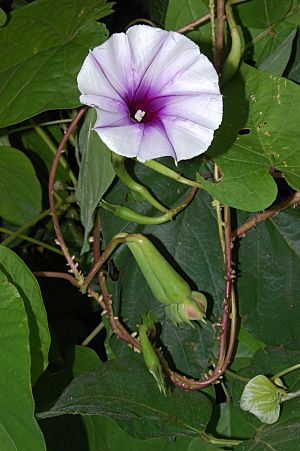Lavender moonvine facts for kids
Quick facts for kids Lavender moonvine |
|
|---|---|
 |
|
| Scientific classification | |
| Genus: |
Ipomoea
|
| Species: |
muricata
|
| Synonyms | |
|
Homotypic Synonyms
Heterotypic Synonyms
|
|
Ipomoea muricata, also known as lavender moonvine, is a cool climbing plant. It belongs to the Ipomoea family. This is the same plant group that includes the beautiful morning glory flowers and the yummy sweet potato. This plant originally came from Central America. But now, you can find it growing in many warm, tropical, and subtropical places around the world.
What It Looks Like
The lavender moonvine is a plant that grows very quickly. It climbs by twisting its stems around other plants or structures. Its flowers are shaped like funnels and can be white, reddish, or a pretty lilac color. This lilac color reminds people of lavender flowers, which is why it's called "lavender moonvine."
The stems of the plant are twining, meaning they wrap around things. They also have small, rough bumps on them. The leaves are smooth to the touch. They can be shaped like an egg (ovate) or more rounded (orbicular).
How People Use This Plant
People in different parts of the world use the lavender moonvine in many ways. They use various parts of the plant for food, medicine, and sometimes even as a mild poison.
In the Indian state of Kerala, this plant is called clove bean. It is also known as nithya vazhutana. The part of the plant that connects the flower to the stem, called the peduncle, can swell up. People in Kerala eat these swollen peduncles. They often pan-fry them or use them in a dish called thoran.
See also
 In Spanish: Ipomoea muricata para niños
In Spanish: Ipomoea muricata para niños

